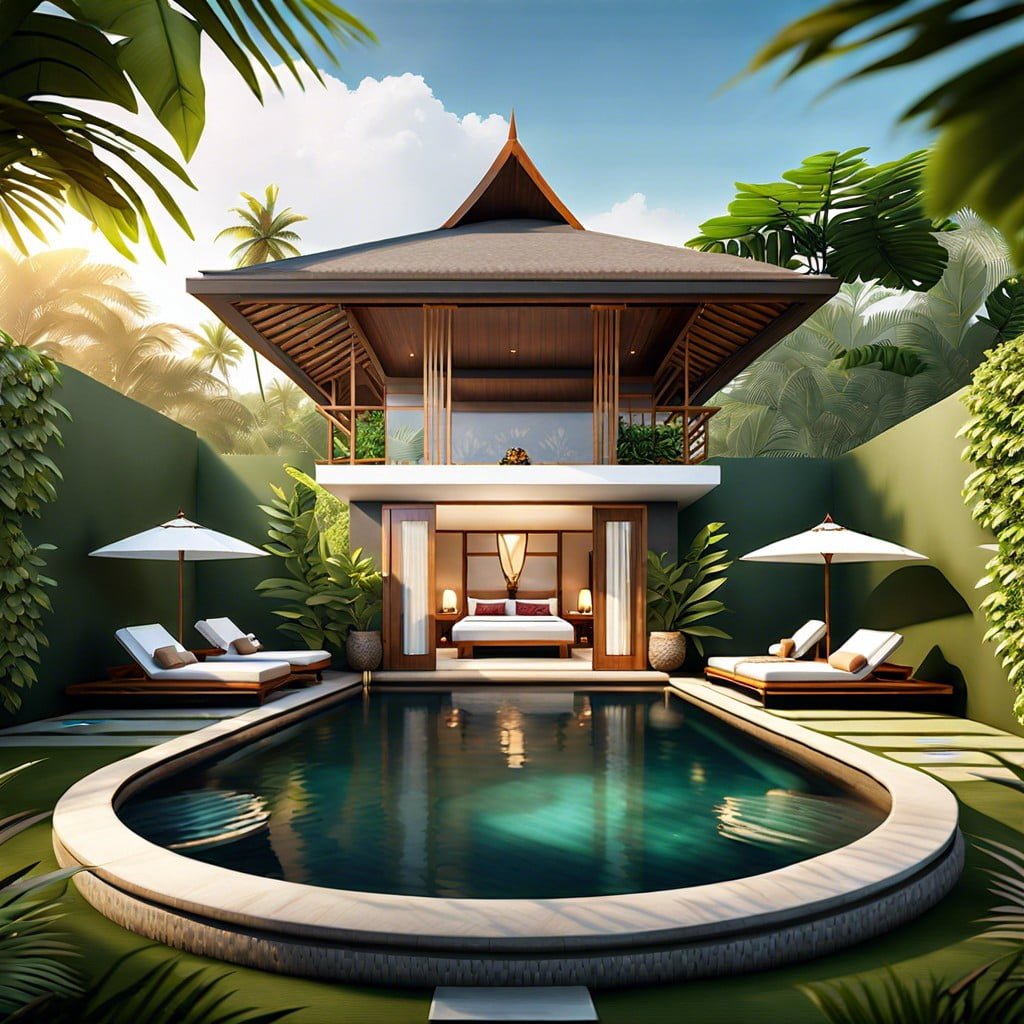Explore the chic versatility of a sarong cover-up because it effortlessly transcends from a beach staple to a style resplendent enough for sunny soirees and poolside cocktails.
Key takeaways:
- Sarong cover-ups are versatile and can be used as skirts, dresses, pants, shawls, and more.
- Choose the ideal fabric for your sarong cover-up, such as lightweight cotton or luxurious silk.
- Explore different tying techniques to create various styles and looks with your sarong.
- Sarongs are perfect for beachside lounging, poolside gatherings, summer parties, and even beach weddings.
- Consider color coordination, print and pattern selection, and size and length when pairing a sarong with swimwear.
Defining the Sarong Cover-Up

The sarong cover-up, a rectangle of fabric, wraps gracefully around the waist or body, doubling as a stylish and practical piece for beachside or poolside lounging.
Originating from the Malay archipelago, it has become an international symbol of tropical ease and elegance.
Lightweight and breathable, it’s crafted from materials like cotton, silk, or rayon, providing comfort and quick-drying properties.
Whether you’re seeking a touch of modesty, protection from the sun, or simply a fashion statement, the sarong’s simplicity allows for a multitude of uses, transcending cultural boundaries and becoming a staple in summer wardrobes.
Its versatility extends to use as a dress, skirt, shawl, or even a makeshift picnic blanket, marking it an essential travel companion for the discerning and style-conscious individual.
Material Choices for Sarong Cover-Ups

When selecting the ideal fabric for a sarong, consider both comfort and function. Lightweight options such as cotton offer breathability and are perfect for hot climates, ensuring ease of movement and a relaxed drape.
Silk sarongs bring a touch of elegance, suitable for upscale resort wear or sophisticated beach events, delivering a luxurious feel against the skin.
For eco-conscious consumers, sustainable choices like bamboo or recycled polyester combine environmental responsibility with practical beachside fashion.
Each material presents a unique texture and flow, influencing the garment’s overall look and feel, essential for creating a personal style statement.
Versatility in Styling Sarongs
The sarong’s adaptability makes it a must-have in any beach or resort wardrobe. It can be draped over the body in numerous ways, transitioning seamlessly from a casual beachside look to a more polished ensemble for dining al fresco.
Here are key points highlighting its versatility:
- As a Skirt: Wrap it around your waist and knot it at the side for a classic beach skirt.
- Dress Transformation: Pull it up over the bust, and secure it behind the neck or over one shoulder for an impromptu dress.
- Pants or Jumpsuit: With a few strategic knots, create makeshift harem pants or a relaxed jumpsuit.
- Shawl or Scarf: Drape over the shoulders to shield from the sun or use as a sophisticated scarf with evening wear.
The beauty of a sarong lies in its simplicity; with a single piece of fabric, you can craft a myriad of looks to suit any occasion by the water.
Sarong Tying Techniques
Mastering the art of sarong tying unlocks a world of elegance at the beach or poolside. One popular method is the skirt wrap, where the fabric is wrapped around the waist and knotted at the hip for a classic, effortless look.
For a secure fit, try the halter dress technique by holding the sarong at your back, bringing the ends over your shoulders, and tying them around your neck.
If a more dynamic silhouette is desired, opt for the side-slit dress, requiring a wraparound and a side knot, creating a tasteful opening along the leg.
Meanwhile, the toga dress is an embodiment of sophistication: drape over one shoulder and secure it at the waist for an airy, chic ensemble.
Additionally, sarong clips offer a no-tie option, clamping the fabric in place for quick, stylish outfit changes.
These techniques each provide a distinct vibe, promoting versatility and personal expression within your beachwear repertoire.
The Occasions for Wearing Sarong Cover-Ups
With its versatility, the sarong cover-up glides effortlessly from beach-side lounging to sophisticated dining. On sun-drenched getaways, it’s the perfect companion, transitioning from a poolside necessity to a chic wrap for casual strolls along the shore.
For a touch of easy elegance at a summer garden party, choose a sarong in a soft, flowing fabric. Those attending beach weddings often embrace the sarong’s ability to offer both formality and comfort, especially in tropical locales.
Additionally, the sarong suits the ambiance at waterfront venues, where its traditionally relaxed essence complements the serene environment. With a clever knot and fold, it even adapts into an impromptu daytime skirt, ideal for impulsive adventures in seaside towns.
Size Considerations for Sarongs
Selecting the correct size of a sarong ensures comfort and enhances its transformative nature. Generally, sarongs come in a one-size-fits-most format, accommodating a broad range of body shapes and sizes.
For a fuller coverage, opt for larger dimensions, particularly if you intend to create more elaborate ties and drapes. Petite individuals might consider a shorter sarong to prevent overwhelming their frame.
Adjustable ties allow for a snug fit, irrespective of your waist measurement. The fabric’s drape and flow are often more critical than the actual size, so focus on the tie’s security and the sarong’s aesthetic when worn.
Remember to account for the potential shrinkage of natural fibers after washing when considering size.
Color and Pattern Selection
Choosing the right color and pattern for your sarong can transform your beachside look. Opt for solid colors to achieve a classic, understated style; these versatile pieces easily match with an array of swimwear.
For a bolder statement, patterns come into play—florals offer a timeless romance, while geometric prints inject a modern edge. Tropical and exotic motifs channel a vacation vibe, perfect for resort wear.
Remember, lighter shades may enhance your summer glow, while deeper tones can provide a striking contrast. When selecting, consider your existing swimwear to ensure a harmonious pairing, as well as your personal color preferences for a cover-up that not only complements but elevates your beach or pool ensemble.
Trending Sarong Designs
Barely-there botanicals and oversized florals are at the foreground of current sarong design trends, mirroring the broader interest in nature-inspired fashion. As beach-goers seek both comfort and style, these patterns offer a fresh nod to tropical aesthetics. Animal prints are also enjoying a resurgence, with leopard and zebra patterns providing an edgy twist to traditional beachwear.
In alignment with a global push towards personal expression, customizable sarongs featuring initials or bespoke color combinations are gaining traction. These bespoke options cater to the discerning customer looking to stand out on the sand.
Tie-dye continues its reign as a beloved design, now reinvented in pastel hues and softer washes for a subtle approach that aligns with the quiet luxury theme. The method’s handcrafted appeal ensures that each piece is as unique as its wearer.
Abstract and geometric prints are making a statement, moving away from the expected nautical stripes and instead offering a modern, art-inspired touch. This shift towards bolder, graphic elements reflects a fusion of art and fashion in everyday wear.
Lastly, reversible sarongs provide a practical yet stylish solution, affording multiple looks within one garment—an appealing feature for the minimalist packer. These design innovations cater to an audience that values versatility and thoughtful consumption.
Sustainable and Artisanal Sarong Options
In an era where ethical fashion choices have become paramount, opting for a sustainable sarong aligns with eco-friendly principles. These sarongs are crafted from organic, recycled, or biodegradable fabrics, reducing environmental impact. Additionally, fair trade certifications assure that artisans are compensated justly for their work.
Artisanal sarongs, often hand-loomed or dyed using traditional methods, support heritage crafts and small communities. Each piece tells a unique story and boasts individuality that mass-produced versions lack. The use of natural dyes also minimizes toxic runoff, protecting ecosystems.
When purchasing, consider brands that transparently disclose their supply chain and sustainability practices. Look for certifications like Global Organic Textile Standard (GOTS) or OEKO-TEX, which indicate adherence to ecological and social criteria.
By choosing a sustainable or artisanal sarong, you contribute to a more responsible fashion industry while enjoying a cover-up rich in authenticity and craftsmanship.
Accessorizing With Sarongs
Elevate your beachwear effortlessly by playing with accessories to complement your sarong. Opt for bohemian-style jewelry, like chunky wooden bangles or beaded necklaces, to add a layer of texture. If a refined look is more your style, a simple gold chain belt cinched at the waist can transform a casual sarong into an elegant statement piece.
For those instances when you transition from seaside to a casual lunch, consider pairing your sarong with a classic straw hat and sunglasses for a chic, sun-protective ensemble. Footwear also plays a crucial role; strappy sandals or espadrilles can finish the look with finesse. And don’t forget the practical yet fashionable tote to carry your beach essentials.
To add an unexpected twist, use a silk scarf to secure your sarong, introducing an additional pattern or pop of color. Remember, the key is to balance the look; allow the sarong to remain the focal point while accessories serve to complement, not overpower.
Cultural Significance of Sarongs
Sarongs are steeped in history and tradition, originating in Southeast Asia where they are known by different names, such as ‘lungi’ in India and ‘pareo’ in Tahiti. These garments are not just a fashion statement but also an integral part of cultural identity, often imbued with symbolic meanings attributed to their colors and patterns. For instance, batik sarongs from Indonesia feature intricate designs that can indicate social status, regional origin, or even marital status.
In Bali, the checkered black and white sarong represents the balance of good and evil, an essential concept in Balinese Hinduism. Similarly, in Malaysia and Indonesia, the songket sarong is an emblem of luxury and status, traditionally worn during ceremonial occasions. Sarongs also play a role in Pacific islander cultures, where they’re essential to traditional dance attire, often showcasing the vibrancy and spirit of island life.
The versatile fabric continues to carry weight in rituals and ceremonies, from Samoan ava ceremonies to Hawaiian hula performances, serving as both a ceremonial garment and a symbol of local craftsmanship. As they make their way into Western wardrobes, it’s important to wear sarong cover-ups with an appreciation for their rich cultural heritage and ongoing significance.
High-End Luxury Sarongs
Luxury sarongs are distinguished by their superior fabric quality, exquisite craftsmanship, and exclusive designs. Discerning fashion enthusiasts invest in these pieces for their longevity and the timeless elegance they offer.
Brands like Hermès and Louis Vuitton often feature silk sarongs, which present vibrant patterns and are sometimes adorned with hand-stitched details. These high-end cover-ups not only elevate beach attire but also transcend to sophisticated evening wear when draped as halter neck dresses or paired with formal accessories.
The investment in a luxury sarong ensures a statement piece that can seamlessly transition from resort wear to a refined ensemble for upscale events.
Pairing Sarongs With Swimwear
When selecting a sarong to complement swimwear, consider the following:
- Color Coordination: Opt for hues that either match or contrast with your swimsuit to create harmony or a striking visual.
- Prints and Patterns: If the swimwear is patterned, choose a sarong with a solid color. Conversely, a vibrant sarong can elevate a solid-color bikini or one-piece.
- Fabric Transparency: Lighter fabrics offer subtlety, while opaque materials provide more coverage and a bolder statement.
- Drape and Length: Assess the cut of your swimwear to decide on the sarong’s drape. Shorter styles work well with high-cut swimsuits, whereas longer sarongs pair nicely with more conservative cuts.
- Texture Play: Mix textures for added interest; a smooth, silk sarong can complement a textured swimsuit, adding dimension to your beach look.
Keep these points in mind for an effortlessly chic poolside or beach ensemble.
The Evolution of the Sarong in Contemporary Fashion
Initially a traditional garment rooted in South-East Asian culture, the sarong has transcended its regional origins, becoming a global fashion staple. As beachwear became more prominent in the 20th century, the sarong emerged as a popular accessory among sun-seekers for its ease of wear and versatility.
In the 90s, the sarong made a notable appearance in the mainstream when David Beckham was photographed wearing one, challenging gender norms and sparking conversations around unisex fashion. This moment highlighted the sarong’s potential beyond traditional uses and as a statement piece.
Contemporary designers have embraced the sarong’s fluidity and have incorporated it into high fashion. Luxury brands now often feature sarongs in resort collections, showcasing them on runways with contemporary prints, luxurious fabrics, and intricate details.
The fashion industry’s current focus on sustainability has also given the sarong new life. Its minimal waste design—often a simple rectangle of fabric—resonates with eco-conscious consumers and designers seeking to reduce their environmental footprint.
Adaptability remains the sarong’s strongest asset, with uses ranging from skirts and dresses to shawls, positioning it as an enduring favorite in the ever-evolving world of fashion.
Price Points for Sarong Cover-Ups
Sarong cover-ups cater to a broad budget range, making them accessible for diverse shoppers. Prices can start as low as $10 for basic, mass-produced pieces made from synthetic materials, providing an affordable option for trend-driven consumers.
Mid-range sarongs, priced between $30 and $100, often feature custom prints or higher quality fabrics like cotton blends.
For the luxurious end, designer labels offer sarongs crafted from silk or eco-friendly textiles, with hand-embellished details that can elevate the price upwards of $200.
The cost is inherently tied to the craftsmanship, fabric quality, brand notoriety, and the ethical production processes involved.
When considering the price, buyers should also weigh the garment’s versatility and longevity, as a higher initial investment might lead to a lower cost-per-wear over time.
FAQ
What is the difference between a sarong and a pareo?
A Pareo, traditionally worn by both men and women in Tahiti and Hawaii, typically larger, encompassing a more versatile styling range from waist wraps to dresses, defines itself as distinct from a Sarong, which is shorter and narrower in comparison.
What is a sarong cover up?
A sarong cover up is a versatile, skirt-like garment primarily used to provide a stylish layer of coverage over swimwear or summer outfits.
Do people still wear sarongs?
Yes, people still wear sarongs today, integrating them into their everyday wardrobes beyond their use in religious and traditional contexts.
How can one style a sarong for different occasions?
One can style a sarong for different occasions by tying it as a dress for an elegant evening, as a skirt for a casual daytime outing, as a shawl for a formal setting, or even as a head wrap for a bold fashion statement.
Which fabrics are best for a sarong cover up?
Lightweight, breathable fabrics such as cotton, linen, rayon, or chiffon are best for a sarong cover-up.
What are the latest trends in sarong fashion?
The latest trends in sarong fashion include elevated fabrics like silk and linen, bold prints such as tropical and abstract, and unique tying techniques like wrap-around skirts or halter dresses.





